
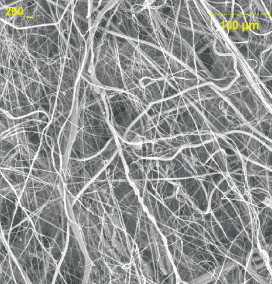
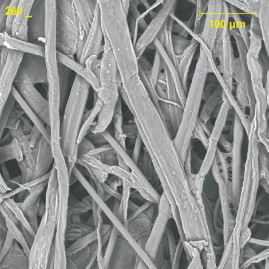
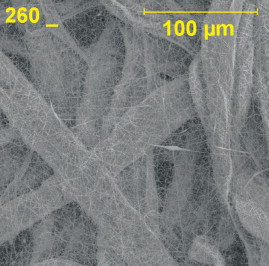
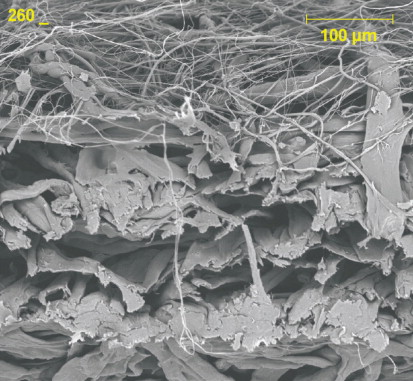
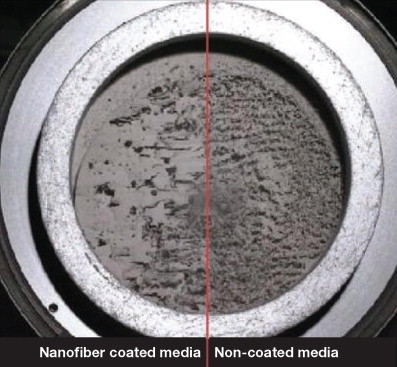
Research and development of nanofibres has gained significant prominence in recent years due to the heightened awareness of their ability to enhance the performance of various forms of filter media. Nanofibre technology, i.e. the fabrication of very small fibres typically having a diameter of less than 1 micron, has been known and practiced for many years. Currently, the most commonly used process for manufacturing nanofibres is the electrospinning process.
This article highlights the drawbacks of the electrospinning process as compared to a new process, nanofibre coating. Further discussed are the advantages of using a nanofibre coating in filtration applications to improve depth filtration and pulse cleaning ability.
Traditional nanofibre technology
Among the most prominent methods of producing nanofibres is the electrospinning method. This process involves the use of a hypodermic needle, nozzle, capillary or movable emitter. These tools provide liquid solutions of the polymer that are then attracted to a collection zone by a high voltage electrostatic field. As the dissolved polymer and solvents are pulled from the emitter and accelerated through the electrostatic zone, fibres are formed through a process of solvent evaporation.
While electrospinning is effective for producing nanofibres, it has drawbacks. At the outset, electrospinning is a very slow process for producing nanofibres on a commercial scale, which increases manufacturing costs. Electrospinning also produces a largely two-dimensional structure that lacks depth or z-directionality. While this configuration is desirable for surface loading, it has limited capability for depth loading applications. Electrospun nanofibres tend to be fairly weak and can be easily damaged or dislodged from the substrate. There remains a need for enhanced nanofibres that overcome the deficiencies of current electrospun nanofibres.
The development of nanofibres has become more prominent in recent years, due to their ability to enhance the performance of filter media, the foundation of efficient air filtration for buildings and other uses.
New nanofibre technology
A newly developed, solvent free nanofibre coating technology can offer greater flexibility, control, and durability compared to the traditional process of electrospinning. This new nanofibre coating is formed from fibres typically ranging from 0.3 to 0.5 microns in size but can be increased up to 1 micron. The fibre diameter distribution and layer thickness can easily be varied according to the application requirements. A wide range of filtration media can be improved through the use of this nanofibre technology.
This new nanofibre layer has a thickness in the range of 15 to 30 microns and is applied directly to the macro filtration substrate. The nanofibre coating can be applied to any nonwoven base material, such as glass, cellulose, or synthetic fibres, while electrospinning is dependent on critical resins for adhesion. A second nanofibre layer of a similar or different polymer can also be applied as a coating. The particular configuration of the substrate will depend on the specific application of the filter media and can be varied to achieve the desired structural properties, including stiffness, strength, pleatability, and temperature resistance.
As indicated, the configuration of the support or base layer can vary depending on the intended use. For heavy duty air, gas turbine, automotive air, and pulse cleaning applications, the support is preferably a wet-laid paper, such as cellulose or a synthetic/cellulose blend. In other markets such as HVAC, liquid, cabin air filters and HEPA filtration, supports can include wet-laid cellulose, glass, synthetic, carded, spunbonds and meltblown nonwovens.
Various nanofibre layers can be positioned at different locations in the filter media according to the application. For example, the nanofibre layer can be positioned upstream, before the macro filtration substrate to enhance surface filtration performance in a gas turbine or heavy duty air application. The nanofibre layer can be positioned downstream of the macro filtration substrate to improve depth filtration in order to capture particles within the body of the media.
Applications for nanofibre coated media
Nanofibres can improve the performance of filter media's ability to remove particulates from air streams. This improvement can be seen in air intake streams of vehicles, computer disk drive ventilation, and high efficiency filtration. In the case of cabin air filters, removing the particulate matter improves the comfort and health of the passengers. Nanofibres offer enhanced filtration performance in both mobile and stationary engines and industrial filtration applications.
With respect to engines, gas turbines and combustion furnaces, it is important to remove particulate material from the air stream supply that can cause substantial damage to the internal components. In other instances, production gases or off gases from combustion engine and industrial processes may contain damaging particulate material. The removal of these particulate is desirable to protect downstream equipment and minimise pollution discharge to the environment.
This new, durable nanofibre coating can also be used in self-cleaning or pulse cleaning filter applications. The dust cake formed on the upstream side of the filter media can be removed by back pulsing air through the media to rejuvenate it. As a great force is exerted on the surface during the back pulse, nanofibre with poor adhesion or comprised of delicate nanofibres to substrates can delaminate as the shock wave moves from the interior of a filter through the substrate to the nanofibre. The new nanofibre technology provides excellent adhesive to the substrate, enabling longer life and improved efficiencies in pulse cleaning applications because of the greater particle collection and overall energy expended during the clearing process.
A much finer surface structure with decreased pore size is formed with the addition of a nanofibre coating, shown in Figure 1, in comparison to a typical cellulose surface shown in Figure 2. An electrospun nanofibre coating, shown in Figure 3, is also very fine, but so fine that the fibres offer little strength and have little depth. The layered structure and depth of the nanofibre coating is shown in Figure 4, the depth of the nanofibre coating illustrates that a nanofibre coating serves not only as a surface filter, but also has a depth filtration aspect that an electrospun coating lacks. The plurality of the nanofibre layers also provides superior durability.
Depth filtration
In contrast to heavy duty air, dust collector and cleanable media, where the nanofibre is applied upstream, there is a benefit to applying nanofibre layers downstream in applications such as automotive air intake, cabin air, fuel and lubrication applications where it is important for particulates to be captured and confined within the air filter media. Particle capture efficiency can be greatly improved by adding a nanofibre layer coated substrate downstream while increasing particle holding capacity. The combination of a more open base sheet with a heavier nanofibre layer results in a composite with not only greater efficiency at the same restriction (or air permeability), but also with significantly improved dust holding capacity.
Measurements of nanofibre coated material clearly demonstrate much better cleanability behavior of the material compared to standard cellulose material. Filter media for cleanable applications have two main functions: To ensure no particles penetrate or pass through the media and to have very high efficiency. For gas turbine applications, high efficiency material protects the sensitive blades of the turbine from dust particles. In industrial cleaning applications, the clean air should have no contaminants as it is circulated through the building. Based on high dust concentration in industrial cleaning environments or in gas turbines located in desert environments, a high efficiency depth filter is not the best solution – air passages in the filter will be blocked due to dust cutting off the air flow. Surface filtration is desired for collecting the dust on the surface of the filter because it creates a homogeneous, linear rise in pressure drop.
Surface structures, where nearly all particles will be captured on the surface from the beginning, will lead to a much better and more homogeneous dust cake if the filtered particles form a coherent dust cake. A highly efficient nanofibre network on the upstream side of filter media prevents the dust from penetrating into the media, resulting in a permanent air flow restriction.
Ideally, the dust cake should be removed as a whole, indicating that no particles have penetrated into the media. Particles that have penetrated the media cannot be removed effectively. As a consequence the dust cake will be ripped apart during the cleaning step and the remaining particles will penetrate the media and result in an increase in pressure drop.
Figure 5 demonstrates the improved cleanability of filtration media when coated with nanofibres. The image shows the dust cake release of filter media that has had one side coated with this new nanofibre technology. The dust cake on the nanofibre coated left side is removed more effectively with several coherent fragments of the dust cake. In the case of the non-coated side on the right, the dust cake is ripped apart because many particles have penetrated the upper layers and are sticking to the surface of the media.
In surface filtration applications the new nanofibre technology provides the required high efficiencies as well as improved cleaning behaviour resulting in lower energy consumption and higher life times.
Next-generation advanced synthetic nanofibre media
Hollingsworth & Vose Company (H&V) is one of the world's leading engineered papers and nonwovens producers. With its advanced R&D and pilot manufacturing facilities, H&V has developed an advanced nanofibre technology to drive value in customers' products. H&V's new NANOWEB® technology provides a microporous structure with unparalleled process control and durability. With this proprietary technology, the fibre diameter distribution and layer thickness can be dialled-in to deliver greater performance across a wide range of applications.
The benefits of NANOWEB® technology can be seen in both air and liquid filtration. NANOWEB® coating can greatly improve the performance of filter media's ability to remove particulates from air streams. This improvement can be seen in air intake streams to dust collectors, gas turbines, cabins of motorised vehicles, HVAC and high efficiency filtration. Various Nanofibre layers can be positioned at different locations in the filter media according to the application. A NANOWEB® coating can be positioned upstream before the macro filtration substrate to enhance surface filtration performance or downstream of the macro filtration substrate to improve depth filtration in order to capture particles within the body of the media. The strong Nanofibre layer adhesion makes NANOWEB® filtration media is ideal for pulse cleaning applications.
NANOWEB® technology can also be specifically designed to meet the stringent filtration requirements of many liquid applications. With improved efficiency, NANOWEB's® synthetic composition offers a more durable Nanofibre option for fuel and lube filtration. It also addresses the growing need for advanced microfiltration as well as RO and UF membrane prefiltration in a variety of liquid service applications including life sciences, food and beverage and process liquid filtration. H&V's NANOWEB® filtration media offers an average of 40% higher porosity for a given micron rating when compared to standard product offerings. With NANOWEB® technology, H&V offers flexibility in designing filter media and has the experience to provide quality materials on a global scale.
Contact:, Emily Moore, Global Product Manager, Hollingsworth & Vose Email: Emily.Moore@hovo.com, www.hovo.com






